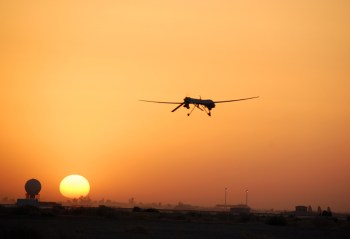An Afghan man surveys the debris after an MQ-1B Predator drone crashed and damaged a pair of homes in the city of Jalalabad last August
It’s an ancient proverb about military snafus wrought by small oversights or neglect that has been recited in various forms for centuries. But the same thing, believe it or not, can still happen with the Pentagon’s 21st Century drones.
It seems an unmanned MQ-1B Predator aircraft had been flying (apparently) near Jalalabad, Afghanistan last August on a classified mission for the U.S. Special Operations Command. As a “hunter-killer” drone, it was likely flying a lazy orbit in the region seeking out Taliban insurgents to attack with its AGM-114 Hellfire missiles. Suddenly, its operator — sitting at a console at Cannon Air Force Base, N.M., nearly 8,000 miles away – noted it “was falling out of the sky” at an uncommanded rate of 1,200 feet per minute.
Now, let’s return to that ancient proverb:
For want of a nail the shoe was lost.
— The Air Force never set a limit on how long the Predator’s variable pitch propeller quill shaft should be used before being replaced. That’s the sliver of metal that keeps the Predator’s propeller blades cutting into the air at the proper angle.
For want of a shoe the horse was lost.
— As the MQ-1B operator “was `busy’ preparing to comply with a new classified tasking,” the quill shaft snapped after 17.2 hours of flight. The MQ-1B was flying at 18,000 feet some 20 miles from its unidentified forward operating base at the time.
For want of a horse the rider was lost.
— The broken shaft allowed the Predator’s propeller blades to flatten out relative to the air.
For want of a rider the message was lost.
— The cockeyed propeller increased the aerodynamic drag on the drone.
For want of a message the battle was lost.
— The Predator entered a steep dive as the operating crew at Cannon declared an emergency and handed control of the wounded drone over to the landing crew in Afghanistan.
For want of a battle the kingdom was lost.
— The Predator landing crew in Afghanistan, realizing the Predator was “over a city” and diving too steeply to make it back to their base, used its on-board camera to locate an open field as an emergency landing site.
But its dive was steeper than anticipated.
The Predator eventually crashed 1.7 miles away from its forward operating base, about 18 minutes after the operator first detected the loss of altitude. The steeper dive kept it away from the open field its landing crew had selected.
Instead, it crashed into a “civilian residential area.”
Beyond the destruction of the $3.8 million drone and its Hellfire missile, the crash damaged two Afghan dwellings. “The U.S. Army Foreign Claims Commission made a payment to compensate the owners of the damaged residential structures shortly after the mishap,” the report said, without citing how much was paid (the Air Force said Tuesday that “operational security” kept it from releasing the amount).

Air Force
“It is likely that the failed variable-pitch propeller quill shaft was the originally installed quill shaft and had been used in the MRPA for approximately 10,243.4 flight hours,” the probe concluded. “The manufacturer of the MQ-1B, had an internal document defining the MQ-1B variable-pitch propeller quill shaft serviceable life at less than 10,243.4 flight hours…However, at the time of the mishap no USAF maintenance or Technical Order guidance defined the serviceable life of the quill shaft.”
Concluded Major Gardner Joyce, who led the investigation into the crash:
I find by a preponderance of the evidence that the lack of USAF maintenance guidance defining the serviceable life of an MQ-1B variable-pitch propeller quill shaft substantially contributed to the mishap.
At least the AGM-114 Hellfire missile didn’t explode, and no one on the ground was hurt. It’s almost funny, in a sad way: military pilots have died trying to fly their crippled aircraft away from schools and homes. That, obviously, is not an option with unmanned aircraft.


